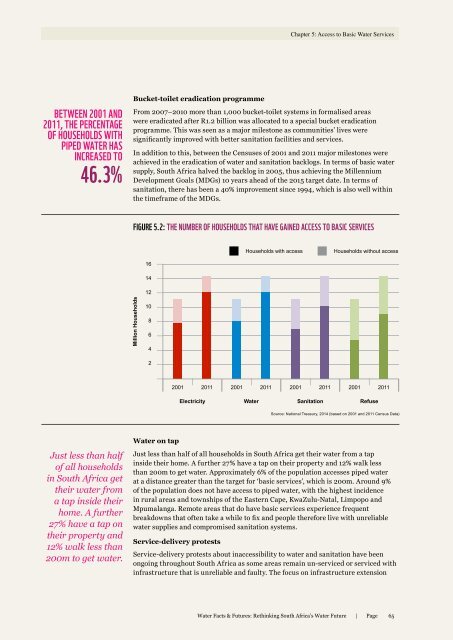55UXOuRjI
55UXOuRjI
55UXOuRjI
Create successful ePaper yourself
Turn your PDF publications into a flip-book with our unique Google optimized e-Paper software.
Chapter 5: Access to Basic Water Services<br />
BETWEEN 2001 AND<br />
2011, THE PERCENTAGE<br />
OF HOUSEHOLDS WITH<br />
PIPED WATER HAS<br />
INCREASED TO<br />
46.3%<br />
Bucket-toilet eradication programme<br />
From 2007–2010 more than 1,000 bucket-toilet systems in formalised areas<br />
were eradicated after R1.2 billion was allocated to a special bucket eradication<br />
programme. This was seen as a major milestone as communities’ lives were<br />
significantly improved with better sanitation facilities and services.<br />
In addition to this, between the Censuses of 2001 and 2011 major milestones were<br />
achieved in the eradication of water and sanitation backlogs. In terms of basic water<br />
supply, South Africa halved the backlog in 2005, thus achieving the Millennium<br />
Development Goals (MDGs) 10 years ahead of the 2015 target date. In terms of<br />
sanitation, there has been a 40% improvement since 1994, which is also well within<br />
the timeframe of the MDGs.<br />
FIGURE 5.2: THE NUMBER OF HOUSEHOLDS THAT HAVE GAINED ACCESS TO BASIC SERVICES<br />
Households with access<br />
Households without access<br />
Source: National Treasury, 2014 (based on 2001 and 2011 Census Data)<br />
Just less than half<br />
of all households<br />
in South Africa get<br />
their water from<br />
a tap inside their<br />
home. A further<br />
27% have a tap on<br />
their property and<br />
12% walk less than<br />
200m to get water.<br />
Water on tap<br />
Just less than half of all households in South Africa get their water from a tap<br />
inside their home. A further 27% have a tap on their property and 12% walk less<br />
than 200m to get water. Approximately 6% of the population accesses piped water<br />
at a distance greater than the target for ‘basic services’, which is 200m. Around 9%<br />
of the population does not have access to piped water, with the highest incidence<br />
in rural areas and townships of the Eastern Cape, KwaZulu-Natal, Limpopo and<br />
Mpumalanga. Remote areas that do have basic services experience frequent<br />
breakdowns that often take a while to fix and people therefore live with unreliable<br />
water supplies and compromised sanitation systems.<br />
Service-delivery protests<br />
Service-delivery protests about inaccessibility to water and sanitation have been<br />
ongoing throughout South Africa as some areas remain un-serviced or serviced with<br />
infrastructure that is unreliable and faulty. The focus on infrastructure extension<br />
Water Facts & Futures: Rethinking South Africa’s Water Future | Page<br />
65


